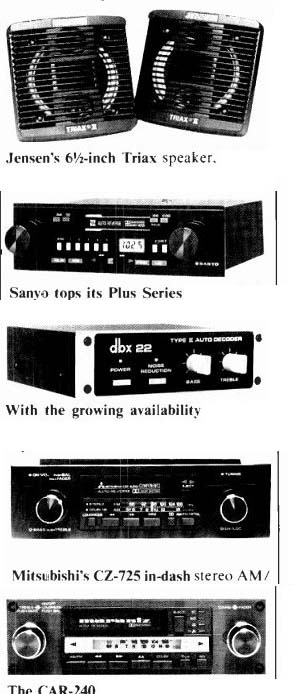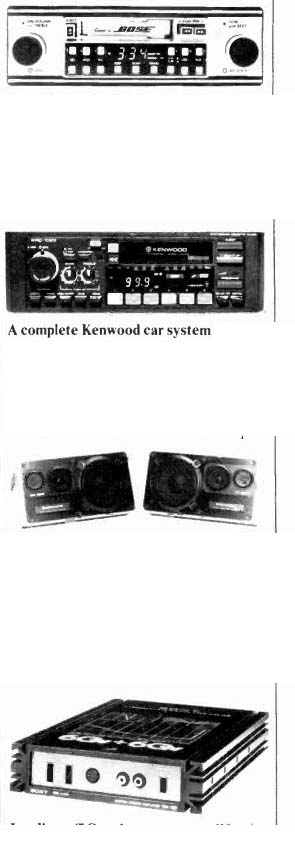The Autophile, by Robert Angus--Two developments foretell profound improvement in stereo FM reception.
What you should know about car stereo.
A Peek at the Future
IF THINGS WORK OUT the way I think they will, two new developments shown at the recent Summer Consumer Electronics Show foretell a profound improvement in the weakest area of car stereo performance: FM stereo reception. Both the Carver Corporation and NAD have developed circuitry that at tacks some problems of FM reception in a moving car-among them multipath distortion and fluctuating signal strength. Though demonstrated in a home tuner by Carver and a personal portable receiver by NAD/Proton (see Peter Dobbin's overview of new audio electronics in last month's issue), I'll wager that by this time next year these proprietary circuits will start showing up in car receivers.
Because patents are pending, the developers are guarded in their descriptions of what the circuits do and how they do it. Basically, however, the Carver approach uses an FM detector that reduces multipath-induced distortion to below audibility (at least to my ears) as well as a circuit that dramatically lowers noise on weak stereo broadcasts without resorting to bandwidth limiting or blending of high frequencies. Though NAD makes no claims of multipath cancellation, its tuner's sensitivity is so high that it actually exceeds what used to be considered the theoretical limit-a trait it shares with Carver's design.
Though these innovative-and, as yet, mysterious-tuners excited much interest, a good deal of attention at the Summer Consumer Electronics Show was also paid to the Philips/Sony digital Compact Disc, which was demonstrated for the first time to the industry. Though its primary incarnation will be in home playback units (supplementing the standard analog record with a fully digital one), Sony chairman Akio Morita hints that in the not too distant future the Compact Disc might find its way into automobiles.
Of course, it will be a while before these super-tuners and superdiscs come to car stereos, but meanwhile here are some selected goodies new this fall.


Jensen's 6 1/2-inch Triax speaker, Model J-1279, is designed to fit in the small rear-deck area of compact cars. The three-way system, with grille-mounted tweeter and midrange, requires less than 2 inches of mounting depth and can therefore also be installed in most car doors, says Jensen. Rated at a power-handling capacity of 75 watts, the Triax J-1279 costs $140 per pair.
With the growing availability of DBX encoded prerecorded cassettes and the increasing popularity of DBX-equipped cassette decks, it was only a matter of time before DBX tackled the car market.
And, with the Model 22 Auto Decoder, the extremely low noise and extended dynamic range made possible by DBX Type II noise reduction is finally avail able in car stereo systems. The Model 22 costs $150.
Tririmm
The CAR-240 from Marantz tackles the problem of maintaining clean FM stereo reception in a moving vehicle with a multimode circuit called an interference management system (IMS). Aimed at reducing multipath-induced noise as well as noise created by weak stereo signals, the circuit moves progressively from high blend to bandwidth limiting as signal conditions demand. Other features of this stereo AM/FM cassette player include Dolby B noise reduction, automatic reverse, and switchable 120/70-microsecond playback EQ, for playing chrome, chrome equivalent, ferrichrome, and metal tapes. In addition, there's a continuous-music system that automatically activates the tuner section whenever the tape transport is in a fast-wind mode. The CAR-340 costs $330.
Sanyo tops its Plus Series of car decks with the FT-590. This feature-packed stereo AM/FM/cassette player combo incorporates a frequency-synthesized tuning section with ten station presets ( five AM and five FM), automatic signal-seeking scan tuning, automatic re verse. Dolby B noise reduction, and an LCD frequency readout. A special de vice to prevent tape jamming is welcome news to those of us who've lost tapes be cause we didn't realize that there was slack in a cassette before loading it:
When a tension sensor in the tape trans port detects slack, the direction is automatically reversed to take up the play.
The FT-590, which also incorporates a music-search system for finding desired tape selections, costs $380.
Mitsubishi's CZ-725 in-dash stereo AM/ FM /cassette deck measures only 6 1/4 by 2 by 4 3/4 inches and has line-level outputs for connection to a power amplifier.
When it's switched to AM, the tuning dial glows amber; for FM, it's green.
Other features include fader and balance controls for four speakers, separate bass and treble controls, a DX/local switch, Dolby B noise reduction, and an equalization switch to accommodate metal, chrome, chrome-equivalent, and ferri-chrome tapes, as well as standard ferries. Price is $270.
The latest from Bose is the CRC tuner/ cassette player ($450) whose line-level outputs are designed to drive the earlier Model 1401 booster/equalizer/speaker system, forming an all-Bose car stereo system. The CRC's cassette player features switchable equalization (120 and 70 microseconds), Dolby noise reduction, automatic reverse, and a tape-direction indicator. Its tuner section offers automatic scan tuning, presets for six AM and six FM stations, and high-blend circuitry to lower noise on weak FM stereo broadcasts.

A complete Kenwood car system selected from the top-of-the-line components in that company's group of seventeen new auto-sound products would include the KRC- 1022 in-dash tuner/cassette deck ($650), the KAC-901 power amp ($370), rated at 100 watts into 4 ohms, and a pair of KSC-701B three-way surface-mount speaker systems ($230 per pair) with 4-inch woofers. Features of the KRC-1022 include synthesized tuning with a digital frequency display, twelve station pre sets, Dolby B noise reduction, metal tape capability, a ceramic tape head, a loud ness control, and a high filter.
Leading off Sony's new car amplifier introductions is the XM-120, rated at 60 watts per side into 4 ohms. The amp incorporates a two-stage power supply that is said to maximize efficiency, keeping battery drain low. A BASS DRIVE filter circuit allows use in subwoofer applications, and separate bass and treble switches boost response 3 or 6 dB at 80 Hz and 12 kHz. The XM-120, dubbed The Earthquake by Sony, costs $330.
144 Bose 148 Mitsubishi 145 DBX 149 Sanyo 146 Jensen 150 Sony
---------------------
Also see:
ACOUSTIC RESEARCH (AR) speakers [ad]